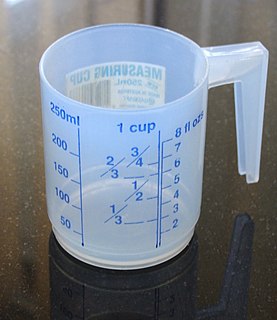Related Research Articles
The British thermal unit is a unit of heat; it is defined as the amount of heat required to raise the temperature of one pound of water by one degree Fahrenheit. It is also part of the United States customary units. The modern SI unit for heat energy is the joule (J); one BTU equals about 1055 J.
Density is the substance's mass per unit of volume. The symbol most often used for density is ρ, although the Latin letter D can also be used. Mathematically, density is defined as mass divided by volume:

The gallon is a unit of volume in imperial units and United States customary units. Three different versions are in current use:

The litre or liter is a metric unit of volume. It is equal to 1 cubic decimetre (dm3), 1000 cubic centimetres (cm3) or 0.001 cubic metre (m3). A cubic decimetre occupies a volume of 10 cm × 10 cm × 10 cm and is thus equal to one-thousandth of a cubic metre.

Ton is the name of any one of several units of measure. It has a long history and has acquired several meanings and uses.

United States customary units form a system of measurement units commonly used in the United States and U.S. territories since being standardized and adopted in 1832. The United States customary system developed from English units which were in use in the British Empire before the U.S. became an independent country. The United Kingdom's system of measures was overhauled in 1824 to create the imperial system, which was officially adopted in 1826, changing the definitions of some of its units. Consequently, while many U.S. units are essentially similar to their imperial counterparts, there are significant differences between the systems.

Volume is a measure of occupied three-dimensional space. It is often quantified numerically using SI derived units or by various imperial units. The definition of length (cubed) is interrelated with volume. The volume of a container is generally understood to be the capacity of the container; i.e., the amount of fluid that the container could hold, rather than the amount of space the container itself displaces.
The cubic foot is an imperial and US customary (non-metric) unit of volume, used in the United States and the United Kingdom. It is defined as the volume of a cube with sides of one foot in length. Its volume is 28.3168 L.
The barrel of oil equivalent (BOE) is a unit of energy based on the approximate energy released by burning one barrel of crude oil. The BOE is used by oil and gas companies in their financial statements as a way of combining oil and natural gas reserves and production into a single measure, although this energy equivalence does not take into account the lower financial value of energy in the form of gas.
The therm is a non-SI unit of heat energy equal to 100,000 British thermal units (BTU), and approximately 105 megajoules, 29 kilowatt-hours, 25200 kilocalories and 25.2 thermies. One therm is the energy content of approximately 100 cubic feet of natural gas at standard temperature and pressure. However, the BTU is not standardised worldwide, with slightly different values in the EU, UK, and USA, meaning that the energy content of the therm also varies by territory.

A barrel is one of several units of volume applied in various contexts; there are dry barrels, fluid barrels, oil barrels, and so forth. For historical reasons the volumes of some barrel units are roughly double the volumes of others; volumes in common use range approximately from 100 to 200 litres. In many connections the term drum is used almost interchangeably with barrel.
The heating value of a substance, usually a fuel or food, is the amount of heat released during the combustion of a specified amount of it.
Actual cubic feet per minute (ACFM) is a unit of volumetric flow. It is commonly used by manufacturers of blowers and compressors. This is the actual gas delivery with reference to inlet conditions, whereas cubic foot per minute (CFM) is an unqualified term and should only be used in general and never accepted as a specific definition without explanation. Since the volumetric capacity refers to the volume of air or other gas at the inlet to the unit, it is often referred to as "inlet cubic feet per minute" (ICFM).
Gasoline gallon equivalent (GGE) or gasoline-equivalent gallon (GEG) is the amount of an alternative fuel it takes to equal the energy content of one liquid gallon of gasoline. GGE allows consumers to compare the energy content of competing fuels against a commonly known fuel, namely gasoline.
A standard cubic foot (scf) is a unit used both in the natural gas industry to represent an amount of natural gas and in other industries where other gases are used. It is the unit commonly used when following the customary system, a collection of standards set by the National Institute of Standards and Technology. Another unit used for the same purpose is the standard cubic metre (Sm3), customary when using SI units.
Standard cubic feet per minute (SCFM) is the molar flow rate of a gas expressed as a volumetric flow at a "standardized" temperature and pressure thus representing a fixed number of moles of gas regardless of composition and actual flow conditions. It is related to the mass flow rate of the gas by a multiplicative constant which depends only on the molecular weight of the gas. There are different standard conditions for temperature and pressure, so care is taken when choosing a particular standard value. Worldwide, the "standard" condition for pressure is variously defined as an absolute pressure of 101,325 pascals, 1.0 bar, 14.73 psia, or 14.696 psia and the "standard" temperature is variously defined as 68 °F, 60 °F, 0 °C, 15 °C, 20 °C, or 25 °C. The relative humidity is also included in some definitions of standard conditions.
Various governmental agencies involved with environmental protection and with occupational safety and health have promulgated regulations limiting the allowable concentrations of gaseous pollutants in the ambient air or in emissions to the ambient air. Such regulations involve a number of different expressions of concentration. Some express the concentrations as ppmv and some express the concentrations as mg/m3, while others require adjusting or correcting the concentrations to reference conditions of moisture content, oxygen content or carbon dioxide content. This article presents a set of useful conversions and formulas for air dispersion modeling of atmospheric pollutants and for complying with the various regulations as to how to express the concentrations obtained by such modeling.
Energy is defined via work, so the SI unit of energy is the same as the unit of work – the joule (J), named in honour of James Prescott Joule and his experiments on the mechanical equivalent of heat. In slightly more fundamental terms, 1 joule is equal to 1 newton metre and, in terms of SI base units
The flow coefficient of a device is a relative measure of its efficiency at allowing fluid flow. It describes the relationship between the pressure drop across an orifice valve or other assembly and the corresponding flow rate.
References
- ↑ Definitions of the BG Group in the United Kingdom